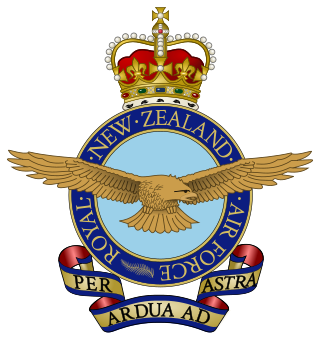
The Royal New Zealand Air Force is the aerial service branch of the New Zealand Defence Force. It was formed from New Zealand elements of the British Royal Air Force, becoming an independent force in 1923, although many RNZAF aircrew continued to serve in the Royal Air Force until the end of the 1940s.

RAAF Base Richmond is a Royal Australian Air Force (RAAF) military air base located within the City of Hawkesbury, approximately 50 kilometres (31 mi) North-West of the Sydney Central Business District in New South Wales, Australia. Situated between the towns of Windsor and Richmond, the base is the oldest base in New South Wales and the second oldest in Australia. The base is home to the transport headquarters RAAF Air Lift Group, and its major operational formations, Nos. 84 and 86 Wings. The main aircraft type operated at the base is the Lockheed C-130 Hercules. Richmond is a regular venue for air shows and had at times been mooted as a site for Sydney's proposed second international airport.
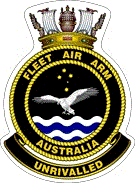
The Fleet Air Arm (FAA), known formerly as the Australian Navy Aviation Group, is the division of the Royal Australian Navy (RAN) responsible for the operation of aircraft. The FAA was founded in 1947 following the purchase of two aircraft carriers from the Royal Navy. FAA personnel fought in the Korean War and the Vietnam War, and participated in later conflicts and operations from host warships.

No. 4 Squadron is a Royal Australian Air Force squadron composed of the air force special forces Combat Controllers, aircrew who operate the Pilatus PC-21 aircraft and instructors for the Australian Defence Force Joint Terminal Attack Controller (JTAC) course.

No. 36 Squadron is a Royal Australian Air Force (RAAF) strategic transport squadron. It operates Boeing C-17 Globemaster III heavy airlifters from RAAF Base Amberley, Queensland. The squadron has seen active service flying transport aircraft during World War II, the Korean War, the Indonesia–Malaysia Konfrontasi, the Vietnam War, and the wars in Afghanistan and Iraq. It has also supported Australian humanitarian and peacekeeping operations around the world, including Somalia, Cambodia, East Timor and Indonesia.
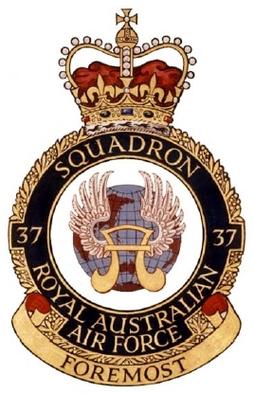
No. 37 Squadron is a Royal Australian Air Force (RAAF) medium tactical airlift squadron. It operates Lockheed Martin C-130J Hercules aircraft from RAAF Base Richmond, New South Wales. The squadron has seen active service flying transport aircraft during World War II, the Vietnam War, the wars in Afghanistan and Iraq, and the military intervention against ISIL. It has also supported Australian humanitarian and peacekeeping operations around the world, including in Somalia, East Timor, Bali, Papua New Guinea, and the Philippines.
No. 292 Squadron is a Royal Australian Air Force (RAAF) operational conversion unit based at RAAF Base Edinburgh, South Australia. The squadron was formed on 1 January 1977 as the Maritime Analysis Training Squadron and renamed No. 292 Squadron on 27 October 1980. Throughout its history it has formed part of No. 92 Wing and been responsible for training aircrew to operate the RAAF's Lockheed P-3 Orion and Boeing P-8A Poseidon maritime patrol aircraft. It took responsibility for training Poseidon maintenance and operations personnel in 2018.
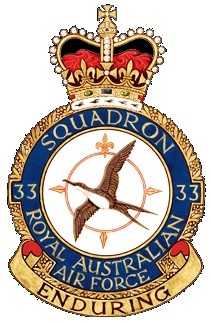
No. 33 Squadron is a Royal Australian Air Force (RAAF) strategic transport and air-to-air refuelling squadron. It operates Airbus KC-30A Multi Role Tanker Transports from RAAF Base Amberley, Queensland. The squadron was formed in February 1942 for service during World War II, operating Short Empire flying boats and a variety of smaller aircraft. By 1944 it had completely re-equipped with Douglas C-47 Dakota transports, which it flew in New Guinea prior to disbanding in May 1946.

No. 34 Squadron is a Royal Australian Air Force (RAAF) VIP transport squadron. It operates Boeing 737 Business Jets and Dassault Falcon 7Xs from Defence Establishment Fairbairn in Canberra. The squadron was formed in February 1942 for standard transport duties during World War II, initially flying de Havilland DH.84 Dragons in Northern Australia. In 1943 it re-equipped with Douglas C-47 Dakotas, which it operated in New Guinea and the Dutch East Indies prior to disbanding in June 1946.
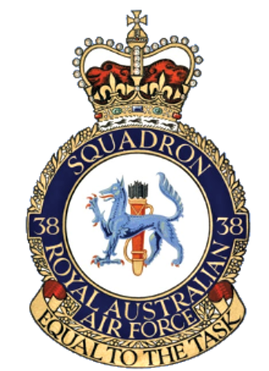
No. 38 Squadron was a Royal Australian Air Force (RAAF) transport and training unit active between 1943 and 2018. It was formed on 15 September 1943 and saw service during World War II transporting supplies and personnel between Australia and the combat zones in New Guinea and Borneo, using Douglas Dakota aircraft. Following the war, the squadron conducted regular courier flights between Australia and Japan in 1947 and 1948. No. 38 Squadron was deployed to Singapore from 1950 to 1952, supplying Commonwealth forces engaged in the Malayan Emergency and undertaking courier flights across Asia. In 1954 it became responsible for training RAAF personnel to operate Dakotas.

No. 5 Squadron was a Royal Australian Air Force training, army co-operation and helicopter squadron. The squadron was formed in 1917 as a training unit of the Australian Flying Corps in Britain, readying pilots for service on the Western Front. It subsequently became a naval fleet co-operation squadron, but was later redesignated as No. 9 Squadron RAAF before being re-formed as an army co-operation squadron during World War II. In the mid-1960s, it was re-formed as a helicopter squadron, before being disbanded in December 1989, when it was used to form the Australian Defence Force Helicopter Training School.

No. 86 Wing is a Royal Australian Air Force (RAAF) transport and air-to-air refuelling wing. Coming under the control of Air Mobility Group, it is headquartered at RAAF Base Amberley, Queensland. The wing comprises No. 33 Squadron, operating Airbus KC-30 tanker-transports, No. 36 Squadron, operating Boeing C-17 Globemaster III heavy transports, and the Australian Army's 68 Ground Liaison Section. Its aircraft support Australian military and humanitarian operations worldwide.

No. 84 Wing is a Royal Australian Air Force (RAAF) transport wing. Coming under the control of Air Mobility Group (AMG), it is headquartered at RAAF Base Richmond, New South Wales. The wing comprises No. 35 Squadron, operating Aliena C-27J Spartan transport Aircraft; No. 37 Squadron, operating Lockheed Martin C-130J Super Hercules medium transports; and a technical training unit, No. 285 Squadron.

The Royal Australian Air Force's Air Combat Group (ACG) is the group which administers the RAAF's fighter and bomber aircraft. ACG was formed on 7 February 2002 by merging the RAAF's Tactical Fighter Group and Strike Reconnaissance Group in an attempt to improve the speed with which the RAAF can deploy its combat aircraft.

No. 35 Squadron is a Royal Australian Air Force (RAAF) transport unit. Formed in 1942, No. 35 Squadron operated during World War II, transporting cargo and passengers around Australia, New Guinea and the Netherlands East Indies, equipped with a variety of aircraft including the Douglas Dakota. It was disbanded after the war, but was re-raised in the 1960s for service during the Vietnam War, flying transportation and resupply operations with DHC-4 Caribous in support of Australian and US forces. The squadron was subsequently augmented with rotary-wing aircraft, operating UH-1 Iroquois in both the transportation and gunship roles. In the late 1980s, the squadron returned to a solely fixed-wing transport role. It ceased operations in 2000, but was re-raised in January 2013. It began re-equipping with C-27 Spartan transports in 2015.

Wing Commander Linda Mary Corbould, is a retired officer of the Royal Australian Air Force (RAAF), who was the first woman to command a RAAF flying squadron. She joined the RAAF in 1981, and became one of its first female pilots in the early 1990s. Corbould flew transport aircraft, including during the Iraq War in 2003, and commanded No. 36 Squadron from 2006 to 2008. She retired from the RAAF in 2011, but remains an officer in the Air Force Reserve.
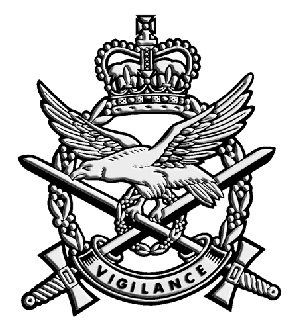
Australian Army Aviation (AAAvn) is a corps of the Australian Army. It was formed on 1 July 1968, although it has a history dating back to 1911, when the Minister of Defence at the time, Senator George Pearce, decided there should be a flying school in the Defence Department. The motto of the Australian Army Aviation corps is Vigilance.
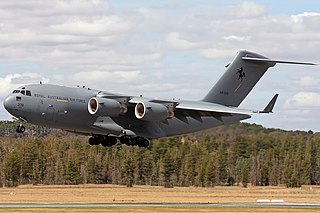
The Royal Australian Air Force (RAAF) operates eight Boeing C-17 Globemaster III large transport aircraft. Four C-17s were ordered in mid-2006 to improve the ability of the Australian Defence Force (ADF) to operate outside Australia and its region. The aircraft entered service between November 2006 and January 2008, the second pair being delivered ahead of schedule. Two more Globemasters were ordered in 2011, the sixth being delivered to the RAAF in November 2012. Another two C-17s were ordered in October 2014, with the final aircraft being delivered in November 2015. The Globemasters are built to the same specifications as those operated by the United States Air Force (USAF), and the Australian aircraft are maintained through an international contract with Boeing.
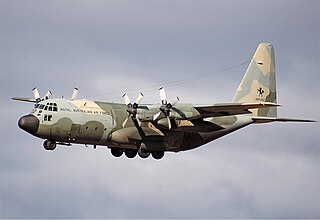
The Royal Australian Air Force (RAAF) has operated forty-eight Lockheed C-130 Hercules transport aircraft. The type entered Australian service in December 1958, when No. 36 Squadron accepted the first of twelve C-130As, replacing its venerable Douglas C-47 Dakotas. The acquisition made Australia the first operator of the Hercules after the United States. In 1966 the C-130As were joined by twelve C-130Es, which equipped No. 37 Squadron. The C-130As were replaced by twelve C-130Hs in 1978, and the C-130Es by twelve C-130J Super Hercules in 1999. No. 37 Squadron became the RAAF's sole Hercules operator in 2006, when No. 36 Squadron transferred its C-130Hs before converting to Boeing C-17 Globemaster III heavy transports. The C-130Hs were retired in November 2012, leaving the C-130J as the only model in Australian service.

No. 486 Squadron was a maintenance unit of the Royal Australian Air Force (RAAF). It was formed in August 1946 as part of No. 86 (Transport) Wing, which operated Douglas C-47 Dakotas out of RAAF Station Schofields, New South Wales. The squadron transferred to RAAF Station Richmond in June 1949. It relocated again to RAAF Base Canberra in April 1954, before returning to Richmond in August 1958 to commence maintenance of No. 86 Wing's newly delivered Lockheed C-130 Hercules. The squadron was disbanded between August 1964 and March 1966. In the 1980s and 1990s, it was responsible for servicing the RAAF's Boeing 707 tanker/transports, as well as the Hercules. No. 486 Squadron was again disbanded at Richmond in October 1998, and its functions handed over to No. 86 Wing's Hercules squadrons.





















